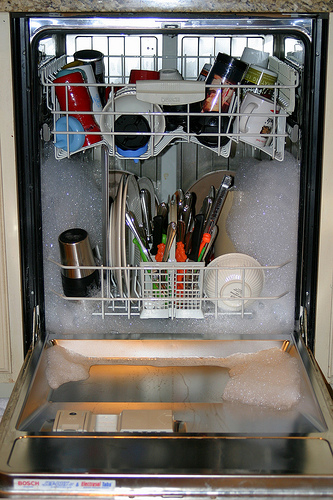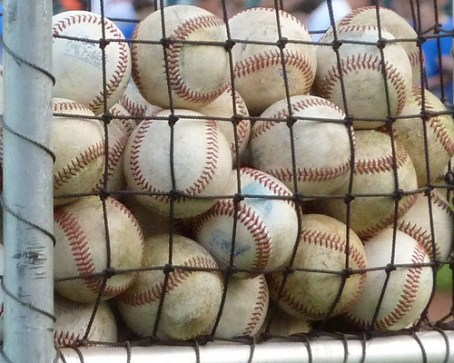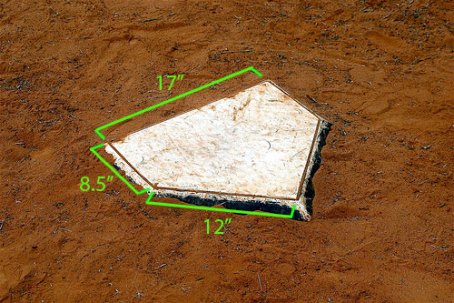Posts tagged ‘baseball’
Things You Didn’t Know You Could Clean (or Cook!) in Your Dishwasher
By Kaye Nemec
Dishwashers were an amazing invention. Long gone are the days of hand washing and drying dishes every night. Now we can simply load up the dishwasher, turn it on and wake up to a fresh load of sparkly, clean dishes.
What many of my fellow dishwasher-loving friends may be pleased to learn is that your dishwasher has some major, hidden potential that extends way behind your basic dinner plate and water glass. Below is an extensive list of items that can also be washed in your dishwasher BUT, before scrolling down read this: your dishwasher can also be used for cooking.
It’s true. And of all things, salmon seems to be the most popular choice for dishwasher cuisine. Sounds like a bad internet rumor but it has been proven accurate over and over again. Check out this recipe if you’re so inclined.
Trying to prepare a Thanksgiving meal for your entire extended family? Save yourself some time by throwing all your baked potatoes in the dishwasher. They won’t cook and/or mash themselves but it will save you the time of having to scrub them all clean!
Now, on to that list of other dishwasher safe items…
- Baseball caps
- Small toys
- Flip-flops
- Garden tools (without wood handles)
- Plastic hair brushes and combs
- Toothbrushes
- Fake flowers (on a light setting)
- Kitchen sponges, vegetable brushes etc.
- Makeup brushes
- Hubcaps and wheel covers
- Pet toys
- Broom heads and dust pans
- Fan faceplates
- Sports equipment (shin guards, knee pads, golf balls etc.)
- Vent covers
- Window screens
- Keyboards (some swear by this, some would never trust it)
Broken Secrets | Facebook | Twitter | Email | Kindle
Sources: Real Simple, Home Ever After , The Bachelor Guy
Photo: tidefan (cc)
Pro Baseball Teams Use 900,000 Balls Each Year
By Kaye Nemec
It’s the top of the 6th inning in the Milwaukee Brewers vs. Washington Nationals baseball game and the TV announcers just provided me, and the rest of the at-home audience, with an interesting fact. According to the Brewer’s equipment manager, 6 dozen brand new baseballs are prepared before each home game. Some games an additional 2 or 3 dozen balls will be used before the final out.
And that got me researching…
On average, Major League Baseball teams go through 900,000 baseballs each season. Any time a ball is thrown in the dirt, dinged by a bat or scuffed up, it is taken out of the game and of course, all homerun and foul balls go home with a lucky fan. Thousands of additional balls are tossed into the stands by generous players.
In order to prevent teams from having to travel with dozens of balls, equipment managers have agreed that the home team will provide the away team with 6 dozen balls before each game. Individual teams are still responsible for providing their own batting practice balls – which is usually 14 or 15 dozen balls, some of which are brand new and some that have been used in a game.
Some used balls are also sent to minor league teams to use for practice. Thankfully 900,000 balls are not simply thrown out each year. However, some would argue they are still a complete waste given the price tag. If you calculate in tax and shipping, the average cost of a dozen baseballs is $72.00. That means the MLB is spending around $5.5 million dollars each season on baseballs alone.
Sources: Post-Gazette
Photo: Paul Hadsall
Rulebook Specs for Home Plate are Impossible
By Chad Upton | Editor
The earliest known reference to “baseball” comes from a 1744 British publication called, “A Little Pretty Pocket-Book” by John Newbery. At the time, the field was triangular and used poles instead of bases. This game was brought to America sometime before 1791, when the first American reference is found in a town bylaw for Pittsfield, Massachusetts.
Of course, the game has changed a lot since then. The infield is has gome from triangular to “diamond” (square) shaped. Home base was originally a round metal plate, which is why it is often called “home plate.” Home plate became a square shape in the 1870s, making it jus t like the rest of the bases.
The rear point of home plate sat at the intersection of the baselines from first and third bases. Although this point never changed, in the year 1900, home plated went from four sides to five.
The front of the base was squared in relation to the pitcher. This was done to make it easier for the pitcher to see the left and right edges of the base. When the base was a square, there was only a small point on each side, which was difficult to see and could easily be covered with dirt. Having a long edge rather than a small point also makes it easier for the umpire to see if the ball passes over the base and make an appropriate call.
The official Major League Baseball rulebook specifies the dimensions for home plate. They say it should be a 12 inch square with two corners filled in so one edge (facing the pitcher) is 17 inches. It also specifies that the two sides should be 8.5 inches. That sounds good on paper, but that is an impossible shape to create — according to Pythagorean theorem. If the 12 inch sides are supposed to be at a right angle to each other, then the hypotenuse would be 17 inches according to the rulebook. Mathematically, the hypotenuse would have to be 16.9 inches.
Some would say it’s a small difference, but it’s actually a large difference in modern day manufacturing tolerances. Either way, the point stands: nobody can create a home plate with the exact specifications set in the rulebook.
Broken Secrets
Get secrets on: Facebook | Twitter | Email | Kindle
Sources: MLB.com, wikipedia (baseball, home plate), MAA
Photo: JC Derr (cc / graphics overlaid)
How Ballparks Stripe Their Grass
In North America, professional baseball fields are the highest form of manicured lawns. Elsewhere, professional football pitches and cricket fields are admired.
Achieving the striped affect is pretty straight forward. The grass appears lighter and darker because the blades of grass are bent in opposite directions. The lighter looking grass reflects more light because of the angle of its blades and the darker ones reflect less light because of their angle.
To bend grass in opposite directions, start by cutting the lawn in opposite directions. The back and forth method is the simplest example.
Most people cut their lawn like that anyway, but the stripes aren’t as dramatic as the professional fields. To improve the contrast, be sure to set your mower at its highest setting. Longer blades of grass bend better and will have a more dramatic look. In fact, longer grass makes for greener grass too — it protects the roots from drying out and turning yellow.
But, here’s the professional stripe trick, after cutting at least two different directions, roll the grass with a lawn roller. Roll the lawn in the same direction that you mowed, this bends the grass better, which intensifies the affect.
Lawn rollers can be bought or rented at many home and garden stores.
Broken Secrets | Written By: Chad Upton
Source: Scotts
Photo: pamhule (cc)








